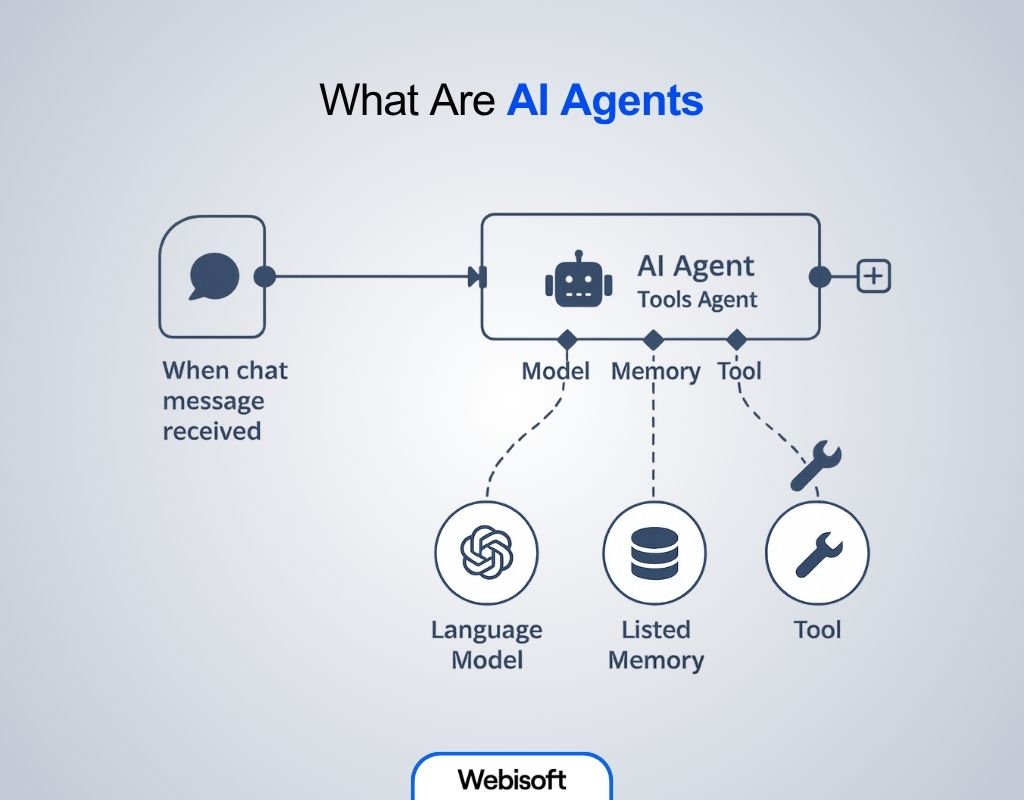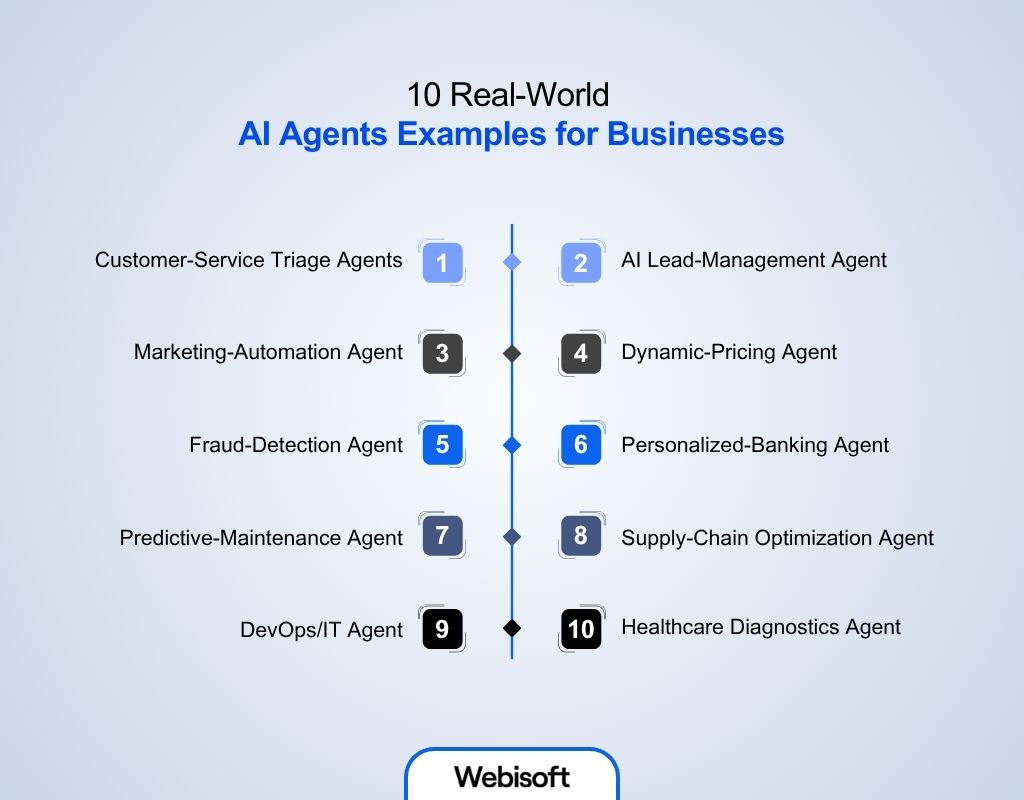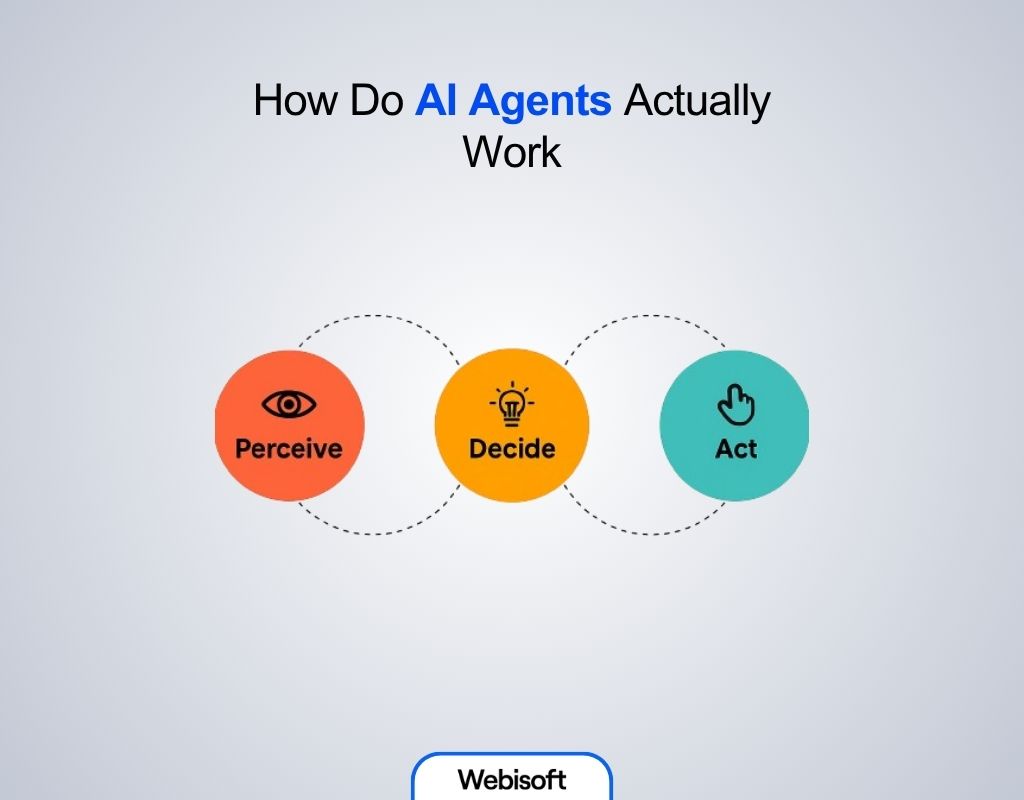10 Real-World AI Agents Examples for Businesses in 2025
- BLOG
- Artificial Intelligence
- October 15, 2025
AI agents are quietly turning cost centers into growth engines. They field support tickets, tweak prices, and spot fraud all day with no breaks. This way teams can hit revenue targets without hiring sprees.
Knowing which agents do what can give you an early edge. AI agents examples show how agents are helping a business succeed and in which sector of your business they can extend their capability. Some common examples are:
- Customer-service triage bots
- Dynamic-pricing engines
- Fraud detectors
- Lead-scoring assistants
- Predictive-maintenance watchers
Each one ingests data, decides next steps, acts, and learns, finishing real business jobs with minimal human help. Curious to know more? Keep reading ahead.
Contents
- 1 What Are AI Agents
- 2 Plan an AI agent for your business with Webisoft now!
- 3 10 Real-World AI Agents Examples for Businesses
- 3.1 1. Customer-Service Triage Agents
- 3.2 2. AI Lead-Management Agent
- 3.3 3. Marketing-Automation Agent
- 3.4 4. Dynamic-Pricing Agent
- 3.5 5. Fraud-Detection Agent
- 3.6 6. Personalized-Banking Agent
- 3.7 7. Predictive-Maintenance Agent
- 3.8 8. Supply-Chain Optimization Agent
- 3.9 9. DevOps/IT Agent
- 3.10 10. Healthcare Diagnostics Agent
- 4 How Do AI Agents Actually Work
- 5 Types of AI Agents
- 6 Who Needs AI Agents
- 7 Want to Build an AI Agent? How Webisoft Can Help You
- 8 Plan an AI agent for your business with Webisoft now!
- 9 Conclusion
What Are AI Agents
You give your digital teammate a goal, and it figures out the rest without a prompt. That’s the short version of what is an AI agent and what it does.
An AI agent plans the steps, makes decisions in real time, and tweaks its strategy as new messages roll in. It records what works, discards what doesn’t, and gets sharper every loop.

So, the short definition is that it is a system that perceives its environment, makes decisions, and takes actions autonomously to achieve specific goals.
How AI Agents are Different from Ordinary AI and Chatbots
Often people confuse AI agents with an AI chatbot. But they aren’t the same. If you are not working with an expert team of AI agent developers like Webbisoft, you need to be very careful about it.
Chatbots are conversational interfaces, which follow predefined flows and cannot choose their own next step.
On the other hand, an AI agent is an autonomous software entity and goal-driven software. It uses the reasoning power of the underlying model plus tool access, memory, and planning. Here are the differences:
| Dimension | AI Agent | Chatbot |
| Core purpose | Achieve a user-defined goal end-to-end by deciding, planning, and acting | Hold a conversation and return scripted or model-generated answers |
| Autonomy | Proactive; can trigger itself, choose tools, and change plans on the fly | Reactive; responds only to user prompts in the chat window |
| Decision-making & planning | Multi-step reasoning, evaluates options, builds action sequences | Follows fixed dialogue trees or simple intent matching |
| Tool & system access | Calls APIs, databases, or other agents to change the external world | May query limited integrations but only on user request |
| Learning & adaptation | Learns from outcomes and adjusts strategy in real time | Little or no self-improvement; relies on manual updates |
| Typical use cases | IT ticket resolution, supply-chain optimisation, autonomous report generation | FAQ answering, appointment booking, basic support triage |
| Interaction modality | May converse, run silently in background, or coordinate with other agents | Text or voice chat interface is the product |
| Limitation | Requires robust guardrails and tool permissions to stay on task | Breaks when queries fall outside scripted paths or context windows |
Choose a chatbot for quick, repetitive dialogue, such as FAQs, appointments, and simple support. Pick an agent AI when the goal spans multiple steps, needs decisions, and touches external systems. In short, chatbots talk; agents act and keep learning while they’re at it. This concept will be clearer with Understanding AI agents.
Plan an AI agent for your business with Webisoft now!
Book a quote – Start the journey of building an automated AI agent today!
10 Real-World AI Agents Examples for Businesses

Curious where AI agents actually pays off? The following list includes 10 agents already running in support desks, pricing engines, and factory floors. They’re real life examples of artificial intelligence lifting revenue, slashing costs, and keeping customers happy:
1. Customer-Service Triage Agents
The first AI agent example is a customer service triage agent, an AI-driven front-liner. It reads every email, chat, or voicemail and instantly tags intent and urgency. Then it adds order and routes cases or drafts answers.
Multi-agent systems expand this flow to fully automate triage. This intelligent agent in AI can do the following tasks:
- Auto-classify inquiries by intent and urgency
- Pull order history and CRM notes
- Prioritize VIP or time-sensitive cases
- Suggest quick answers to human reps
- Escalate complex issues to specialists
Proof it works: Convin’s AI triage agent cut average handling time 40% and reduced agent workload 90% across call-center pilots.
2. AI Lead-Management Agent
Among the other examples of agents, this is the second one on our list. The lead-management AI agent embodies modern AI lead generation, using autonomous algorithms to identify, attract, and nurture prospects.
It triages calls, texts, and chats, enriches records with firmographic signals, automates follow-ups, and routes high-value leads. This AI agent can:
- Auto-respond to SMS, calls, and chat 24/7
- Enrich CRM records with firmographics and behavioral tags
- Score and segment leads by intent and likelihood
- Schedule demos, calls, or tasks on rep calendars
- Surface “hot” leads immediately for rapid outreach
Proof it works: Real estate platform Redfin slashed first-response time by 60% using an AI lead-management agent, increasing conversion rates by 20% and reducing rep workload.
3. Marketing-Automation Agent
This is one of the examples of AI agents for marketing purposes. An AI marketing-automation agent simplifies campaign creation and execution across multiple channels.
It drafts social posts, email sequences, and other tasks all from a single dashboard. You can get the following benefits from this agent in AI system:
- Generate social posts, email copy, and ad creatives instantly
- Auto-segment audiences and update lists dynamically
- Schedule and publish content at peak engagement windows
- A/B test subject lines, creatives, and CTAs
- Compile dashboards with real-time performance insights
Proof it works: Crabtree & Evelyn lifted return on ad spend by 30 percent in under two months after an AI marketing agent (Albert) automatically tested audiences and creatives and re-allocated budget in real time.
4. Dynamic-Pricing Agent
This agentic AI adjusts product or service pricing in real time to balance revenue, margin, and competitive positioning. An AI dynamic-pricing agent constantly uses demand, inventory, and competitor data.
Additionally, it also analyzes patterns and exemplifies how agents in AI convert market signals into profits through autonomous actions. This AI agent offers:
- Monitor stock levels and sell-through rates continuously
- Scrape competitor prices and promotional data automatically
- Forecast demand fluctuations by region and time of day
- Compute optimal prices or discounts against margin targets
- Launch flash sales or volume incentives when demand softens
Proof it works: Uber’s ML-powered surge pricing increased revenue by 11% during peak periods. E-commerce retailers use Feedvisor or PricingHub for similar margin and volume gains.
5. Fraud-Detection Agent
Instead of waiting for chargebacks, a fraud-detection AI agent screens every transaction the instant it hits the gateway. It processes high-throughput data streams and evaluates device, IP, behavioral, and historical patterns.
These AI agents examples can also flag anomalies, apply dynamic risk rules, and self-retrain models to outpace evolving new tactics. Here’s what a fraud-detection agent can do:
- Score each transaction for fraud risk within milliseconds
- Cross-validate device, geolocation, and user behavior indicators
- Detect card testing, account takeovers, and mule networks early
- Adapt to new fraud strategies via continuous model retraining
- Auto-block or escalate suspicious transactions for review
Proof it works: PayPal reduced fraud losses by 40% after implementing deep-learning agents. Small merchants integrate Stripe Radar or Forter via API in minutes for comparable protection.
6. Personalized-Banking Agent
A personalized-banking agent is a live, in-app financial coach. It can study each customer’s transactions, balances, and habits in real time. Hence, this agent can predict cash-flow crunches or savings opportunities and then deliver advice.
It can even move money automatically to keep every user on track. That makes it one of the clearest intelligent agent examples you can deploy in finance. The benefits of this AI agent are as follows:
- Classify transactions and highlight unusual spend patterns
- Recommend savings plans, budget adjustments, or debt-payoff paths
- Pre-qualify users for loans, credit increases, or offers
- Streamline onboarding, KYC, and identity verification
- Send context-aware notifications via in-app chat or email
Proof it works: Royal Bank of Canada’s NOMI agent analyzes each customer’s transaction and pushes real-time saving and budgeting tips. The bank credits the agent with sharper cross-sell rates and more effective money-management guidance across its retail base.
7. Predictive-Maintenance Agent
Swap calendar-based servicing with these intelligent agents examples. A predictive-maintenance agent watches your machines in real time. It reads vibration, temperature, and power feeds every second.
When it spots early wear, it estimates each part’s remaining life. Next, it books a work order, orders spares, and alerts technicians. Here’s what this AI agent can do:
- Analyze real-time vibration, temperature, and output metrics
- Identify early warning signs of component fatigue or fault
- Forecast failure dates using statistical and ML models
- Recommend optimal maintenance windows and resource allocation
- Auto-generate work orders and order replacement parts
Proof it works: Siemens cut unplanned turbine downtime by 30% with an AI agent. Mid-size factories deploy Augury or Senseye on top of existing PLC systems in days.
8. Supply-Chain Optimization Agent
One of the common AI agents examples is this agent. An AI supply-chain optimization agent tracks real-time demand, inventory, and logistics metrics. It forecasts needs, reallocates stock, and reroutes shipments on the fly.
These adjustments cut costs and delays, keeping operations resilient even when disruptions ripple through the global network. The supply-chain optimization agent can:
- Predict SKU-level demand weeks or months ahead
- Rebalance inventory across warehouses to prevent stockouts
- Select the most cost-effective and reliable carrier per shipment
- Reroute orders in real time when delays or disruptions occur
- Automate rate negotiations based on volume and performance
Proof it works: DHL boosted on-time delivery rates to 95% using an AI optimization agent. Retailers plug in ClearMetal or o9 Solutions for similar SCM performance gains.
9. DevOps/IT Agent
An AI DevOps/IT agent automates software delivery and infrastructure management within CI/CD pipelines. It scans every commit for bugs and vulnerabilities, writes unit and integration tests, builds containers, and runs blue-green or canary releases.
If key metrics drop, it rolls back automatically, freeing engineers to focus on higher-value tasks. These agents can:
- Scan pull requests for code smells, vulnerabilities, and bugs
- Auto-generate unit, integration, and regression tests
- Build and deploy containers or artifacts across environments
- Orchestrate blue-green, canary, or rolling deployments
- Monitor post-deployment metrics and auto-rollback on failures
Proof it works: GitHub reported engineers code 55% faster using Copilot-enabled review agents. Start-ups adopt Harness or Atlassian Compass to automate end-to-end DevOps workflows in hours.
10. Healthcare Diagnostics Agent
An AI healthcare diagnostics agent pulls EHR notes, MRI images, and live vitals into one view. It spots odd lab spikes. Then it ranks high-risk patients. Next, it hands clinicians clear, evidence-based treatment suggestions.
These tools are AI, not magic, yet misdiagnoses drop, readmissions fall, staff breathe easier, and queues shrink dramatically. Here’s what this AI agent can do:
- Aggregate labs, notes, imaging, and vitals into a unified view
- Detect early sepsis, stroke, or oncology indicators via ML models
- Prioritize patients by risk level on clinician dashboards
- Suggest diagnostic tests and treatment options with citations
- Alert care teams via secure mobile or EMR notifications
Proof it works: Mayo Clinic reduced avoidable readmissions by 25% using an AI triage agent. Community hospitals access similar diagnostics via Aidoc or Zebra Medical’s API-driven platforms.
How Do AI Agents Actually Work

The operation process of AI agents is relatively simple. They work in four basic steps: Perception → Reasoning and Planning → Action → Learning. Here are the steps and what they do:
- Perception: Collects data from sensors, APIs, user input, logs, etc.
- Reasoning and Planning: Uses models (often an LLM) to interpret the data, break the goal into subtasks, and decide next steps.
- Tool Calling/Action: Invokes external tools (APIs, databases, code, robotic actuators, other agents) to execute those steps and move the state of the world toward the goal.
- Learning/Memory: Stores past interactions and performance feedback so it can refine future decisions.
Types of AI Agents
Before learning about the AI agents examples, let’s understand the types of agents first. There are behavioral agent designs and structural extensions. Here’s a table on the types of AI agents:
| Layer | Agent type | Core idea | When to pick it |
| Behavioral (internal decision style) | Simple Reflex | Hard-coded IF→THEN rules; no memory | Fully observable, stable settings |
| Model-Based Reflex | Maintains a world model to fill in unseen facts | Partially observable worlds | |
| Goal-Based | Searches/plots action sequences that reach a goal | Tasks with alternative paths | |
| Utility-Based | Chooses the best goal-reaching option via a utility function | Trade-off scenarios | |
| Learning | Improves its own rules/utility by experience | Dynamic, data-rich domains | |
| Structural (how agents are organised) | Hierarchical | A high-level agent sets sub-goals for lower layers | Complex, multi-scale tasks |
| Multi-Agent System | Several agents cooperate or compete | Distributed or swarm problems |
Who Needs AI Agents
After learning what is an agent in AI facility, you may want to know who actually needs it. You don’t buy a bulldozer to plant tulips. Same logic here.
AI agents shine only when the job is big, messy, and always changing. Below are the situations where an autonomous agent powered by AI really pays off:
- High-volume service desks
- Operations teams that juggle multiple external systems
- IT departments automating routine code fixes
- Logistics and supply-chain planners needing real-time routing
- Manufacturers pursuing predictive maintenance
- Time-sensitive enterprises where delays cost money
- Investors and innovators betting on agentic AI
Want to Build an AI Agent? How Webisoft Can Help You
You now know what is AI agent, the types of AI agents, who needs it, and the practical examples of agents. If you’ve made up your mind about building an AI agent for your business needs, you need a professional hand for perfection.
Webisoft offers AI services that can help you in multiple steps. Here’s what Webisoft can do in this regard:
- Strategic AI consulting to pinpoint high-impact opportunities and align tech choices with business goals
- Custom model development that targets specific pain points and streamlines operations
- Smooth integration of AI agents into current tools, data pipelines, and workflows
- Advanced capabilities—predictive analytics, document search, and multimodal handling of text, voice, and images
- LLM and RAG solutions, including fine-tuned language models and retrieval-augmented chatbots for instant, accurate answers
- Continuous monitoring, updates, and optimization to keep agents effective as needs evolve
- Resilient security and compliance safeguards, meeting standards such as GDPR and HIPAA
Plan an AI agent for your business with Webisoft now!
Book a quote – Start the journey of building an automated AI agent today!
Conclusion
In closing, AI agents examples show how autonomy, reasoning, and continuous learning drive business wins. You can also explore AI agents real-world projects to see how these systems perform in action. As you review workflows, set a clear goal, map the data and tools each step needs, and decide if a single-agent or multi-agent chain suits best.
Use the examples above as a blueprint, then recap quickly to turn small pilots into enterprise-scale impact. Ready to implement AI in your business with Webisoft? Contact them today!


